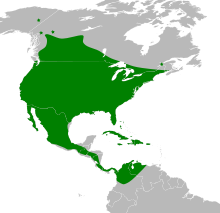Big brown bat
| Big brown bat | |
|---|---|

| |
| A big brown bat on a rock | |
| Scientific classification | |
| Domain: | Eukaryota |
| Kingdom: | Animalia |
| Phylum: | Chordata |
| Class: | Mammalia |
| Order: | Chiroptera |
| Family: | Vespertilionidae |
| Genus: | Eptesicus |
| Species: | E. fuscus
|
| Binomial name | |
| Eptesicus fuscus (Beauvois, 1796)
| |

| |
| Range map | |
| Synonyms | |
| |
The big brown bat (Eptesicus fuscus) is a type of vesper bat. It is found in North America, the Caribbean, and the northern part of South America. The big brown bat weighs 15–26 g (0.53–0.92 oz). It has a wingspan of 32.5–35 cm (12.8–13.8 in).[4]
Description[change | change source]
It is a large microbat. It weighs 15–26 g (0.53–0.92 oz). It is 110–130 mm (4.3–5.1 in) long.[5] Its wingspan is 32.5–35 cm (12.8–13.8 in). Its dorsal fur is reddish brown. Its ventral fur is lighter brown. Its snout, uropatagium, and wings are black and do not have any hair.[5] Its ears are also black and short.[6]
Distribution and Habitat[change | change source]
The big brown bat is found from southern Canada and Alaska to as far south as Colombia and Venezuela. It has also been seen in the Caribbean in both the Greater and Lesser Antilles, including Cuba, Hispaniola, Dominica, Barbados, and the Bahamas. The big brown bat has been seen from 300–3,100 m (980–10,170 ft) above sea level.[7] It is able to live in urban, suburban, or rural environments.[8]
Feeding[change | change source]
Big brown bats are insectivorous. They eat many kinds of insects like beetles, flies, stone flies, mayflies, true bugs, net-winged insects, scorpionflies, caddisflies, and cockroaches.[9]
Behavior[change | change source]
The big brown bat is a nocturnal animal. It roosts in sheltered places during the day. It roosts in mines, caves, tunnels, buildings, bat boxes, tree cavities, storm drains, wood piles, and rock crevices.[8] In the summer, males usually live by themselves though they may form a small group that is only made up of males.[6]
Reproduction[change | change source]
Big brown bat mating season is in the fall. After the breeding season, pregnant females separate into maternity colonies around April.[10] Maternity colonies range in size from 5-700 bats.[6] The pups are blind and helpless. It weighs 3 g (0.11 oz). The pup sucks milk from its mother for one month. Pups begin flying, at three to five weeks old.[5]
References[change | change source]
- ↑ Miller, B.; Reid, F.; Arroyo-Cabrales, J.; Cuarón, A.D.; de Grammont, P.C. (2016). "Eptesicus fuscus". The IUCN Red List of Threatened Species. 2016: e.T7928A22118197. doi:10.2305/IUCN.UK.2016-3.RLTS.T7928A22118197.en.
- ↑ Wood Grinnell, Hilda (1918). A Synopsis of the Bats of California. Vol. 17. University of California Press. p. 318.
- ↑ Hutcheon, James M.; Kirsch, John A. W. (2006). "A moveable face: Deconstructing the Microchiroptera and a new classification of extant bats". Acta Chiropterologica. 8: 8. doi:10.3161/1733-5329(2006)8[1:AMFDTM]2.0.CO;2. ISSN 1733-5329. S2CID 85948117.
- ↑ Shen, Mailing Address; Luray, oah National Park 3655 U. S. Highway 211 East; Us, VA 22835 Phone:999-3500 Emergency Phone: 1-800-732-0911 Contact. "Big Brown Bat - Shenandoah National Park (U.S. National Park Service)". www.nps.gov. Retrieved 2020-10-26.
{{cite web}}: CS1 maint: numeric names: authors list (link) - ↑ 5.0 5.1 5.2 Wisconsin Big Brown Bat Species Guidance (PDF).
- ↑ 6.0 6.1 6.2 Kurta, Allen; Baker, Rollin H. (1990-04-26). "Eptesicus fuscus". Mammalian Species (356): 1–10. doi:10.2307/3504258. JSTOR 3504258. S2CID 253992366.
- ↑ IUCN (2016-08-08). "Eptesicus fuscus: Miller, B., Reid, F., Arroyo-Cabrales, J., Cuarón, A.D. & de Grammont, P.C.: The IUCN Red List of Threatened Species 2016: e.T7928A22118197". doi:10.2305/iucn.uk.2016-3.rlts.t7928a22118197.en.
{{cite journal}}: Cite journal requires|journal=(help) - ↑ 8.0 8.1 Agosta, Salvatore J. (2002). "Habitat use, diet and roost selection by the Big Brown Bat (Eptesicus fuscus) in North America: a case for conserving an abundant species". Mammal Review. 32 (3): 179–198. doi:10.1046/j.1365-2907.2002.00103.x. ISSN 0305-1838.[permanent dead link]
- ↑ "Big Brown Bat (Eptesicus fuscus)". 2007-10-22. Archived from the original on 2007-10-22. Retrieved 2020-10-26.
- ↑ Schwartz, Charles Walsh. (2001). The wild mammals of Missouri. Schwartz, Elizabeth Reeder. (2nd rev. ed.). Columbia: University of Missouri Press. ISBN 0-8262-1359-6. OCLC 47023492.
Notes
- ↑ Sic; possibly a misprint of the word Vespertilio.[2] When first described in 1758, Vespertilio was equivalent to the modern taxonomic order Chiroptera.[3]

